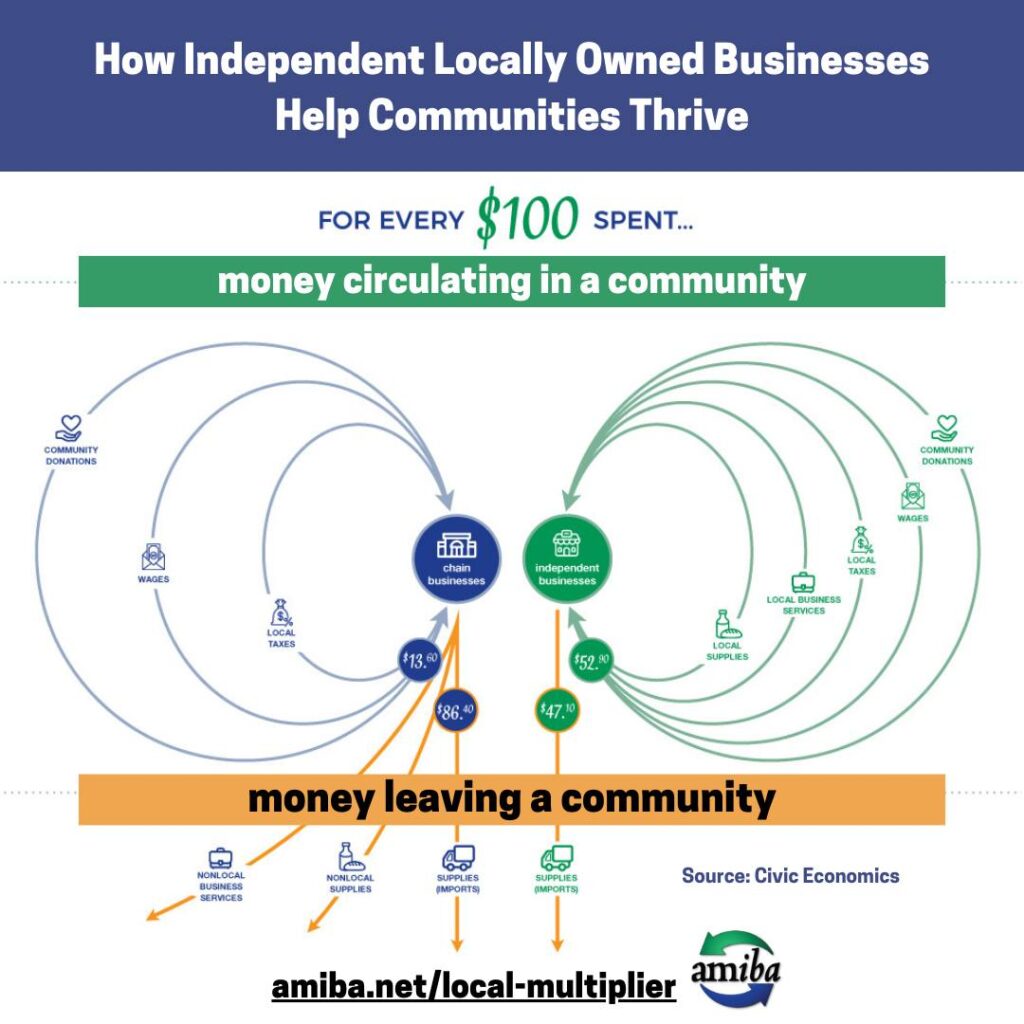by Caroline Tremblay, The Daily Yonder
May 4, 2023
When you put dollars into your retirement fund or investment accounts, where do they go?
To your local food co-op? Housing projects in your region? Local downtown redevelopment?
Probably not, and with good reasons; for decades, it’s actually been illegal for the majority of people to invest locally.
But spurred by rising interest in investment crowdfunding since the passage of the JOBS Act in 2012, an increasing number of stakeholders are asking: How do we change that?
Michael Shuman, a leader in community economics, was considered one of the key architects of the JOBS Act, which enabled companies to access funding in new ways. He’s also helped change a range of state laws to permit broader crowdfunding. Through his advocacy efforts and his books, including Put Your Money Where Your Life Is, Shuman has been planting the seeds of community investment for decades.
Now others, who have used his work as a springboard, are making headway redrawing the blueprint of community economics. Jenny Kassan is an attorney, certified coach, and founder of The Kassan Group; she’s been connected with Shuman since 1991.
Coming from a family of activists and change-makers, Kassan started out in the non-profit world but felt limited by funding and process challenges. She watched the social enterprise movement grow and realized, “There’s a way bigger opportunity to make a huge difference,” she said.
While finance had not been her area of expertise, Kassan found funding strategies for mission-driven businesses. She gathered examples dating as far back as Ben & Jerry’s in 1984. As the ice cream company grew from its beginnings in a converted gas station, owners Ben Cohen and Jerry Greenfield got creative. They leveraged a little-known legal clause to establish a Vermont-only public stock offering.
Today, Kassan and other community investment leaders are finding similar paths to allow locals to invest in their communities. Kassan has collaborated with various rural communities, like Port Townsend, Washington, and Saranac Lake, New York, where primary retail stores were shutting down and leaving residents without nearby necessities.
Not only did these efforts keep dollars local, but in Port Townsend, “they realized the power of community investing, so they actually started this club called the Local Investment Opportunities Network,” Kassan said. The town has since funded many of its own small businesses through local investor support.
“Securities law is definitely complicated, and it’s easy to make mistakes,” Kassan said. “On the other hand, there are a lot of other different options available of how you can do this.” Having a champion who’s familiar with securities law can be key.
Kassan shared a story from Wyoming where a rural region wanted to raise money for a community-owned store. Ultimately, their attorney found a simple route, using a unique intrastate funding law. “Another lawyer might not have thought of it,” Kassan said.
While that loophole was serendipitous, many community investment possibilities are limited by the 1940 Investment Company Act. “It’s very well-intentioned. It’s designed to protect people from making investments in investment funds without getting a lot of disclosure,” Kassan said. However, over time, it has disempowered average citizens from being able to invest locally. Instead, sending money to Wall Street has become the norm.
Kassan has used myriad approaches to empower social entrepreneurs and catalyze changes for more sustainable economies. For her, the most sensible approach is often avoiding coverage under the Investment Company Act altogether.
However, other community investment specialists are doing just the opposite. Chris Miller is a founding board member of the National Coalition for Community Capital (NC3), an organization in Michigan focused on using local capital to create equitable, inclusive, and resilient local economies.
He believes every community should be able to employ its unique assets to launch and manage a community investment fund that provides capital for local businesses and projects.
“We’re in a position now where we have a workaround that we think is going to be largely successful for most communities,” Miller said.
This recent idea was sparked by the Boston Impact Initiative, a non-profit investing fund focused on economic and racial justice. The initiative utilized a charitable loan fund section of the 1940 Act and “made it sing and dance in a way that no other charitable loan fund had ever done,” Miller said.
This begged the question: “Can we do that same thing using another fund but one that will actually allow us to build wealth?” he said. That question resulted in the Diversified Community Investment Fund (DCIF), which is being piloted by NC3 in 2023.
Essentially, if you’re investing in business, stocks, or bonds, that’s a security, and it’s highly regulated. But if you’re investing in real estate, the guidelines aren’t as strict. Based on the law from 1940, “If you set up a real estate fund and it looks like a real estate fund, and it behaves like it, once you do 60% of your investing in real estate, you can do whatever you want to with the other 40%,” Miller said.
With so many communities in urgent need of housing solutions anyway, this workaround, which is being rolled out in three different places across the country already, could be transformative. When Miller called Shuman, his longtime colleague, to tell him about it, Shuman “stopped the conversation and said, ‘Chris, this is exactly what we’ve been looking for 20 years,'” Miller said.
Miller has already seen examples of how community investments can spark additional funding for large projects, as well. One was in Traverse City, Michigan, where out-of-town owners possess the majority of the community’s assets. But year-round residents and tourist-season workers were struggling to find housing and other essential resources.
Through a collaborative effort and with the help of attorney Kate Redman, who became the project director, Commongrounds Cooperative, a mixed-use building with commercial and residential space, came into being. With initial funding sourced from hundreds of local, individual, and commercial investors, the project was also backed by financial input from the region, state, and the U.S. Department of Agriculture.
“The community that was going to be impacted by the project—they were the ones that put up that money, so it really did some wonderful things and gave them a lot of political support,” Miller said.
While politics certainly play a role, Kassan said she struggles with whether legal change is what’s needed to drive growth in community investing.
“The primary problem is more culture and mindset and beliefs,” she said. “It’s just so much easier to tell your 401k manager: ‘Just put my money anywhere into Wall Street.'”
But what could things look like if there were an ecosystem to help local people invest directly in small businesses?
“There’s an inevitability…One way or the other, we’re gonna get there,” Miller said.
Caroline Tremblay is a freelance writer who assists with news coverage of Radically Rural, a two-day summit on rural issues held in Keene, N.H. This year’s event is September 27-28. www.radicallyrural.org
This article first appeared on The Daily Yonder and is republished here under a Creative Commons license.![]()


